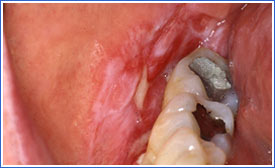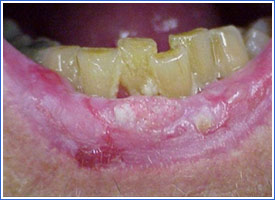Oral Cancer
Ninety percent of oral cancers are squamous cell cancers of the mucosa. If a red or white patch appears and does not resolve, suspect leukoplakia (precancer) or cancer and pursue biopsy of the lesion. The development of a mass or ulcer is a late sign with poorer prognosis.
Prevalence
- Estimated that 58,450 new oral cancers will be diagnosed in 2024
- This accounts for 2.9% of all new cancer cases
- Estimated 12,230 deaths from oral cancer in 2024
- Highest mortality in black males
Epidemiology
- Alcohol and tobacco
- Historically responsible for 75% of oral cancers
- Greater risk for those who smoke pipes or cigars than cigarettes
- Human Papilloma Virus, HPV 16
-
- Accounts for the rising incidence or oral cancers, particularly the posterior pharynx, tonsils and the base of the tongue
- Especially in younger individuals, 40-64
- HPV vaccine may decrease rates of oral HPV infection
- Sunlight (lip cancer)
- Betel nuts
Symptoms
- Red or white patches persisting beyond two weeks
- Ulcers that are non-healing or bleed easily
- Masses
Examples of Oral Cancer


References
HPV Vaccination Linked to Decreased Oral HPV Infections, National Institute of Health, National Cancer Institute, June 5, 2017, Accessed on 1/23/2018
Kalavrezos N, Scully C. Mouth cancers for clinicians Part 6: Potentially malignant disorders. Dent Update. 2015;42(9):866-8, 871-4, 877.
Rhodus NL, Kerr AR, Patel K. Oral cancer: leukoplakia, premalignancy, and squamous cell carcinoma. Dent Clin North Am. 2014;58(2):315-40.
SEER Cancer Stat Facts: Oral Cavity and Pharynx Cancer. National Cancer Institute. Bethesda, MD, https://seer.cancer.gov/statfacts/html/oralcav.html
Cancer Stat Facts: Oral Cavity and Pharynx Cancer, National Cancer Institute, Survelliance, Epidemiology and End Results Program. Oral Cavity and Pharynx Cancer — Cancer Stat Facts. Accessed 11/13/2024